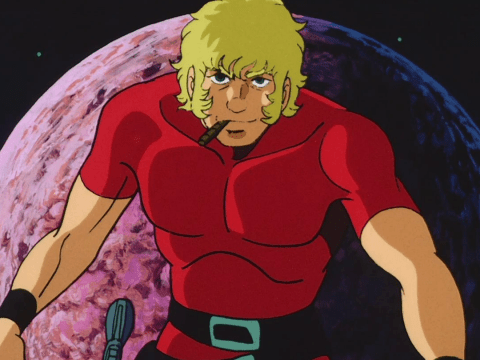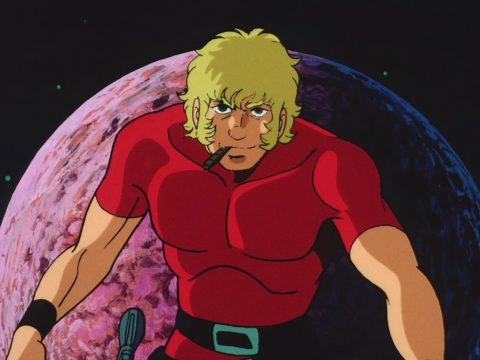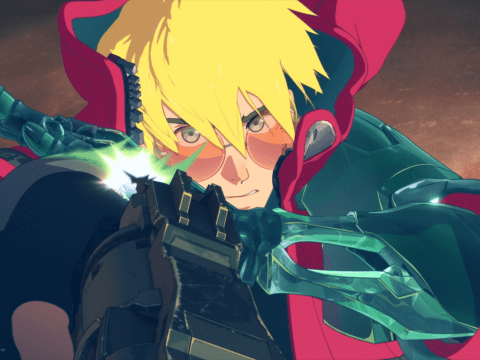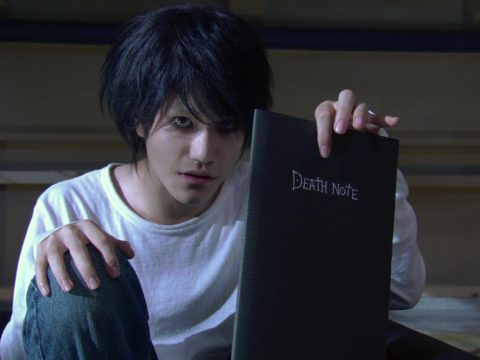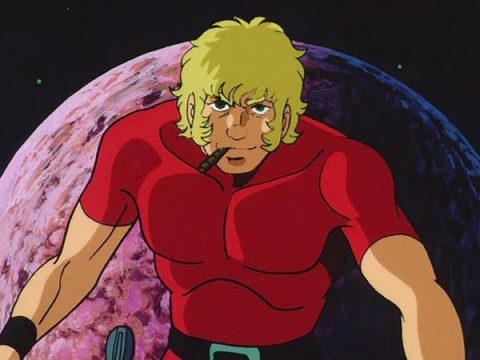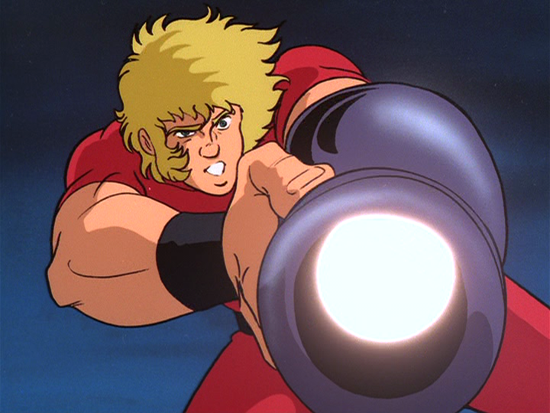
After three decades, the ultimate sci-fi male fantasy anime comes to the U.S. As I’m sitting here typing this, the final episode of Space Dandy has just finished playing on my TV. I can’t help but think that when Shinichiro Watanabe was working on this show, he had Buichi Terasawa’s signature title Space Adventure Cobra in mind. After all, both of them are sci-fi shows that take place in the vast universe and have heroes taking on crazy things, though Cobra is a little different in its tone and style, and feels like a late-night ’80s show, with jazz background themes and heavy contrasts for much of the initial episodes.
We start the show in the distant future where ordinary salaryman Johnson dreams about sleeping in and affording a shapely female android maid instead of the bumbling Ben who can at least serve him a decent cup of coffee. Johnson continues to daydream when Ben suggests he tries a Trip Movie, which can simulate a memory of whatever experience the visitor wants. Johnson heads to the TM place and winds up dreaming he’s a space pirate named Cobra, who travels the galaxy, steals riches, gets women and has fun working with his robotic partner, Armoroid Lady. In this dream, Cobra has a handsome face, long green hair and a superweapon called the Psychogun attached to his left arm. The duo run afoul of the Pirate Guild, a massive criminal organization who are far more cruel with their activities. They pursue him relentlessly and eventually send a representative named Vaiken to try and recruit him. Cobra refuses and instead shoots out Vaiken’s eye, which earns him a 7 billion credit bounty for his death. But Cobra simply disappears into legend…
Johnson wakes up totally refreshed and jazzed up, talking about his experience, but the hostess gets mystified as she didn’t program any pirates for the dream and doesn’t understand where they came from. He heads to a local casino and exclaims, “I’m Cobra! I don’t need a membership here!”, proceeding to win a lot of money. As he cashes out, the casino owner asks to meet him… and happens to look just like Vaiken, with the missing eye and all. The owner simply says his name is Jack Chris and asks his men to take care of Johnson. The men proceed to beat him up for winning too much and prepare to kill Johnson when his left arm begins to glow with a lethal light.
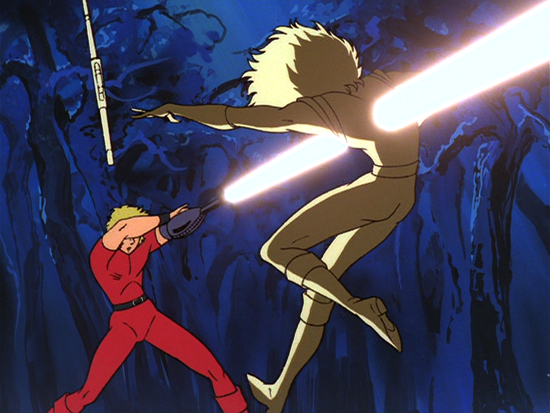
Eventually Johnson comes to realize he IS Cobra and had his own face and memories changed to hide from the Guild. Vaiken comes after him but Ben the robot reassembles itself into Armoroid Lady, the tough faithful partner who saves Cobra again and again. The Guild continues to come after him, even as he’s making his way to his hidden spaceship The Turtle. Along the way, he meets the lovely, capable bounty hunter Jane Flower, who’s been looking for the presumed-dead Cobra. Unfortunately, the guild has been looking for Jane herself as a lead to a long-rumored treasure, and so Cobra is forced to intervene while not letting down a lovely lady.
Thus begins the first big adventure arc of the TV series. It’s somewhat similar to the theatrical film (released here by Discotek Media) in that Cobra has to help 3 women pursued by the Guild leader Crystal Bowie. If your only experience with the character is that film, you’re in for a different experience of sorts. Characters and allegiances are written a good bit differently here, closer to the manga instead. Director Osamu Dezaki (Rose of Versailles, Mighty Orbots) and character designer Akio Sugino (Black Jack, Ashita no Joe) worked on both the movie and the TV series but built them with different vibes. The movie went for a more serious and somber tone with seiyuu Shigeru Matsuzaki giving Cobra a vulnerable, sad quality at times in relation to the situation around him. So when the producers set to work on the TV series, they utilized Nachi Nozawa to make Cobra more mischievous and goofy, though very convincing when he gets ticked off.
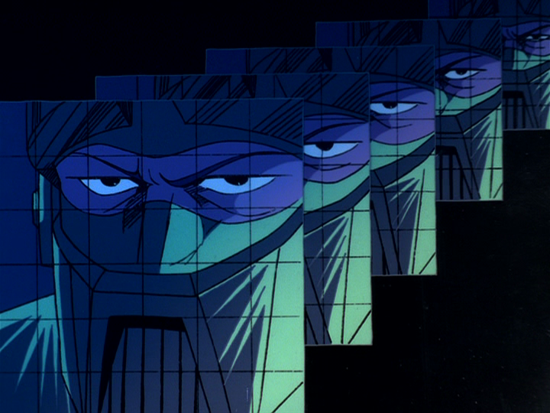
Cobra does go through a range of emotions on these adventures as he battles some rather interesting (and often non-human) adversaries such as Crystal Boy and Tarbeige The Mentalist, a pair of ruthless Pirate Guild operatives. He also runs into sentient swords, a museum guarded by dinosaurs, and a corrupt sports team which he spends several episodes infiltrating. He also hooks up with some of his old piracy buds before heading to a confrontation with the ruler of the Pirate Guild, a mysterious being known as Salamander. There’s a lot of craziness as the stories play out and at times he comes across as a bit too unbelievable (somewhat like Bond), but the show is still fun generally.
Earlier I compared this to the recent Space Dandy anime and it’s really hard not to draw the correlations. Both seem patterned after ’60s/’70s sci-fi. In previous interviews, manga creator Buichi Terasawa mentioned an interest in movies from the west such as Star Wars, Barbarella and James Bond films. The world he’s created here would seem to be a merging of the three, with serious misogynistic tendencies throughout, much like what a middle school kid might create in class. The results are generally fun to watch though probably not the most politically correct anime out there. Terasawa’s obsession with shapely females is prevalent throughout the show in not only the characters but the designs of various structures and vehicles at times. If you’ve ever seen Terasawa’s other animated work Goku: Midnight Eye, you may get a sense of what’s displayed here. There are lots of scantily clad women throughout this show doing all kinds of jobs including police patrols, harvesting, and guard duties, among other things. At one point, Cobra runs into the Snow Guerillas, a vicious all-female criminal group. A lot of these women get knocked around a good bit and, though the show is entertaining overall, this pattern is a bit uncomfortable to notice.
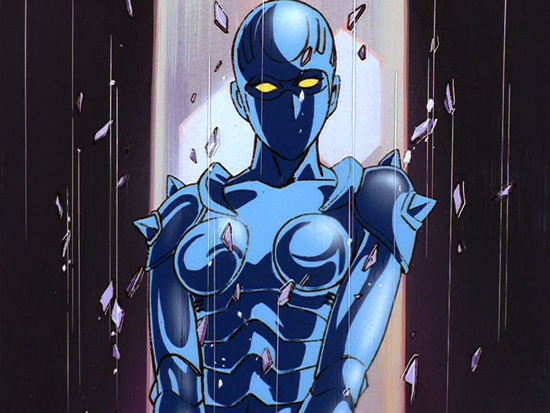
Still, there’s an overall fun vibe through the various adventures Cobra takes on. The animation style lends to this. The art is initially smooth in the first several episodes, with the penchant for sketch and motion lines not appearing until later in the show. Also, Dezaki’s signature “postcard method,” which has the action stop at a still painting for dramatic effect, only appears at commercial breaks in the TV show. These techniques are a bit different than the Cobra movie where sketch lines and the postcard method don’t really appear at all but detailed backgrounds are the order of the day. There are a lot of sped-up movements and some great scenes where the perspective, as it were, dollies around Cobra to bring the viewer closer to the action he’s experiencing. The movements are slick and look best in the high contrast night time scenes, similar to Batman the Animated Series or Wicked City at times. Also, Dezaki proves to be a master manipulator of split screens, much like the TV show 24. For the time, some very innovative animation techniques are at work here.
The video quality on the DVD sets by Right Stuf / Nozomi Entertainment is very nice. The colors are bright and bold, and there’s no artifacting in the picture as I’ve seen in other classic anime projects. There is only Japanese audio throughout the series but the subtitles are yellow and clearly defined for reading. The cover art makes nice use of the manga covers used over the years. The best aspects of theses sets though are the extras, which are fun to go through. The first box set has an English pilot created for an aborted American series (supposedly set to debut on the Playboy channel at the time). This was comprised of original footage merged with scenes from the 13th episode of the Japanese series. As American dub standards for the mid ’80s were different for the time, the performances are decent to listen to, though they change Armoroid Lady’s name to Galaxia. Cobra still comes out of a self-imposed amnesia in this version, though he’s asked to lead a whole resistance movement against the Dark Side Clan here. Yes, either version of the Japanese origin is likely to give you a Total Recall flashback.
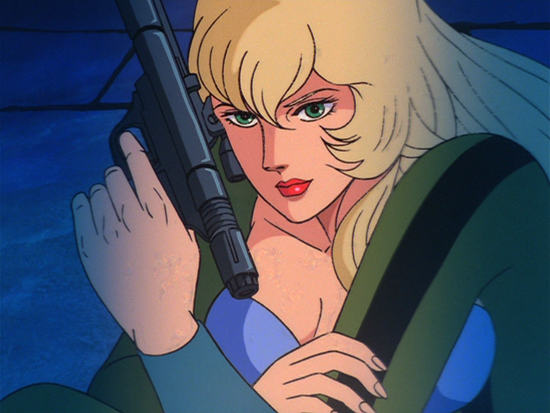
Along with some Japanese promo material, we also get an eighteen minute interview with creator Buichi Terasawa himself, talking about his start in the manga industry after his girlfriend won a contest with art that “sucked,” his early years working under Osamu Tezuka, his innovative use of digital art techniques and the development of his style and influences, among other things. We get a lot of insight from the chain-smoking, ebony-clad legend during this piece (minus the Johnny Cash songs.)
All in all, this is a very nice collection that Right Stuf / Nozomi entertainment has put together. For many years, Space Adventure Cobra was one ’80s series that seemed perfect for American sci-fi fans. I’m very glad to recommend it as a fun yarn for folks’ DVD collections.
Distributor: Right Stuf/Nozomi
Available: Now
© BUICHI TERASAWA/A-GIRL RIGHTS・TMS
For an alternate take, give Daryl Surat’s Space Adventure Cobra feature a read.


